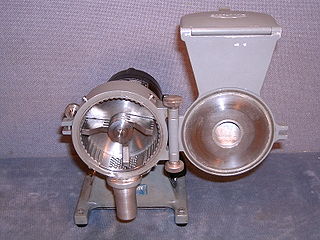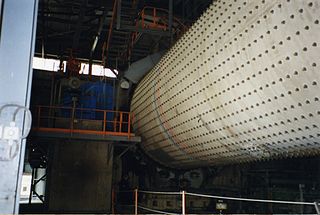
Impact mills are one of two general classes of milling devices used to reduce the particle size of a material.

Impact mills are one of two general classes of milling devices used to reduce the particle size of a material.
The other class of mills are "attrition" or grinding mills. Impact mills pulverize the material upon impact. The feasibility of impact mills was greatly enhanced by the mechanization and engineering of the Industrial Revolution. Prior to the industrial revolution, milling was primarily done by attrition or grinding the material between two surfaces. [1] Attrition milling continues to be the dominant milling class, particularly in the milling of agricultural products (i.e. grain into flour). Roller mills and stone mills are two examples of attrition (grinding) mills.
Impact mills either pulverize the material by simply employing gravity or they can mill dynamically upon impact with a high speed rotor, hammer or pin.
Gravitational impact mills pulverize the material inside a rotating chamber. [2] This is accomplished by a cascading motion of larger pieces repetitively impacting and compressively grinding the product into finer particles as it rotates in the chamber. These are generally referred to as "autogenous" impact mills. This action can be enhanced by placing steel balls in the chamber. The class of gravitational impact mills that incorporate steel balls in the chamber are appropriately referred to as "ball mill".
Dynamic impact would occur when material is dropped into a chamber where it receives a pulverizing blow from a hammer, rotor or pin. [3] Pulverizing can be enhanced by engineering the rotor or hammer [4] to pass close to a serrated fixed stator. Pin, unifine; and VSI mills are examples of dynamic impact mills.

A centrifuge is a device that uses centrifugal force to separate various components of a fluid. This is achieved by spinning the fluid at high speed within a container, thereby separating fluids of different densities or liquids from solids. It works by causing denser substances and particles to move outward in the radial direction. At the same time, objects that are less dense are displaced and move to the centre. In a laboratory centrifuge that uses sample tubes, the radial acceleration causes denser particles to settle to the bottom of the tube, while low-density substances rise to the top. A centrifuge can be a very effective filter that separates contaminants from the main body of fluid.
A crusher is a machine designed to reduce large rocks into smaller rocks, gravel, sand or rock dust.

A ball mill is a type of grinder used to grind or blend materials for use in mineral dressing processes, paints, pyrotechnics, ceramics, and selective laser sintering. It works on the principle of impact and attrition: size reduction is done by impact as the balls drop from near the top of the shell.

A mill is a device that breaks solid materials into smaller pieces by grinding, crushing, or cutting. Such comminution is an important unit operation in many processes. There are many different types of mills and many types of materials processed in them. Historically mills were powered by hand or by animals, working animal, wind (windmill) or water (watermill). In modern era, they are usually powered by electricity.
Micronization is the process of reducing the average diameter of a solid material's particles. Traditional techniques for micronization focus on mechanical means, such as milling and grinding. Modern techniques make use of the properties of supercritical fluids and manipulate the principles of solubility.

A burr mill, or burr grinder, is a mill used to grind hard, small food products between two revolving abrasive surfaces separated by a distance usually set by the user. When the two surfaces are set far apart, the resulting ground material is coarser, and when the two surfaces are set closer together, the resulting ground material is finer and smaller. Often, the device includes a revolving screw that pushes the food through. It may be powered electrically or manually.

In the field of extractive metallurgy, mineral processing, also known as ore dressing, is the process of separating commercially valuable minerals from their ores.

A hammer mill is a mill whose purpose is to shred or crush aggregate material into smaller pieces by the repeated blows of little hammers. These machines have numerous industrial applications, including:
A pulverizer or grinder is a mechanical device for the grinding of many different types of materials. For example, a pulverizer puritch is used to pulverize coal for combustion in the steam-generating furnaces of coal power plants.

A cement mill is the equipment used to grind the hard, nodular clinker from the cement kiln into the fine grey powder that is cement. Most cement is currently ground in ball mills and also vertical roller mills which are more effective than ball mills.

A raw mill is the equipment used to grind raw materials into "rawmix" during the manufacture of cement. Rawmix is then fed to a cement kiln, which transforms it into clinker, which is then ground to make cement in the cement mill. The raw milling stage of the process effectively defines the chemistry of the finished cement, and has a large effect upon the efficiency of the whole manufacturing process.
A VSI mill is a mill that comminutes particles of material into smaller (finer) particles by throwing them against a hard surface inside the mill. Any hard or friable materials can be ground with low value of metal waste. This type of mill is combined with a classifier for fine tuning of a product size.

Granulation is the process of forming grains or granules from a powdery or solid substance, producing a granular material. It is applied in several technological processes in the chemical and pharmaceutical industries. Typically, granulation involves agglomeration of fine particles into larger granules, typically of size range between 0.2 and 4.0 mm depending on their subsequent use. Less commonly, it involves shredding or grinding solid material into finer granules or pellets.
Vertical roller mill is a type of grinder used to grind materials into extremely fine powder for use in mineral dressing processes, paints, pyrotechnics, cements and ceramics. It is an energy efficient alternative for a ball mill.
Comminution is the reduction of solid materials from one average particle size to a smaller average particle size, by crushing, grinding, cutting, vibrating, or other processes. In geology, it occurs naturally during faulting in the upper part of the Earth's crust. In industry, it is an important unit operation in mineral processing, ceramics, electronics, and other fields, accomplished with many types of mill. In dentistry, it is the result of mastication of food. In general medicine, it is one of the most traumatic forms of bone fracture.
The IsaMill is an energy-efficient mineral industry grinding mill that was jointly developed in the 1990s by Mount Isa Mines Limited and Netzsch Feinmahltechnik ("Netzsch"), a German manufacturer of bead mills. The IsaMill is primarily known for its ultrafine grinding applications in the mining industry, but is also being used as a more efficient means of coarse grinding. By the end of 2008, over 70% of the IsaMill’s installed capacity was for conventional regrinding or mainstream grinding applications, with target product sizes ranging from 25 to 60 µm.
A Unifine mill is a single one-pass impact milling system which produces ultrafine-milled whole-grain wheat flour that requires no grain pre-treatment and no screening of the flour. Like the grist or stone mills that had dominated the flour industry for centuries, the bran, germ, and endosperm elements of grain are processed into a nutritious whole wheat flour in one step. Consumers had accepted whole wheat products produced by grist or stone mills. The flour produced by these mills was quite coarse as they included the bran and the germ elements of the grain.
A grinder-mixer is a type of agricultural machine used to process livestock feed from grain. A grinder-mixer is a portable mill that combines the mixing and grinding operations.
Dry milling of grain is mainly utilized to manufacture feedstock into consumer and industrial based products. This process is widely associated with the development of new bio-based associated by-products. The milling process separates the grain into four distinct physical components: the germ, flour, fine grits, and coarse grits. The separated materials are then reduced into food products utilized for human and animal consumption.